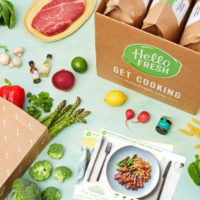On-demand food delivery is exploding. From prepared meals, to groceries, to restaurant delivery, diners increasingly crave their food at the tap of a button. While the consumer demand is there, delivery remains a major pain point for restaurants. Setting up the infrastructure and hiring and training additional staff is something that many small operators cannot afford.
Los Angeles-based ordering platform ChowNow wants to make delivery easy for restaurants, and it has partnered with Uber’s on-demand delivery service UberRUSH to make it happen. Through the partnership, ChowNow hopes to get the 50 percent of its restaurant clients that currently do not deliver on the delivery band wagon, while enabling those that do deliver to lower their delivery costs and expand their reach. UberRUSH seamlessly integrates with ChowNow’s ordering technology, and the delivery feature is customizable for restaurants. They can turn it off depending on how busy they are, and they also have flexibility on who covers the UberRUSH delivery cost, which is generally $3 per delivery and $3 per mile.
ChowNow founder Chris Webb says its delivery feature all about “control, customization and scalability for restaurants.” The UberRUSH collaboration is one of many new features ChowNow is launching with the $10M Series B it raised in March 2015 led by Upfront Ventures. We caught up with Webb to learn more about how the partnership works, the impact he hopes it will make and how it upholds ChowNow’s philosophy that “restaurants and their brands should be in the foreground.” Our interview has been edited for brevity and clarity.
_______________
Food+Tech Connect: Why did ChowNow decide to add delivery to its ordering and marketing platform?
Chris Webb: Delivery is a huge and growing pain point for restaurants. Wages are increasing across the country, insurance rates continue to climb, and staffing peak delivery times has always been a nightmare. Because of these challenges, only half of our restaurant clients offer delivery today, and the other half only offer pickup. With UberRUSH delivery, we’re introducing a whole new revenue stream for our clients and making integration as easy as flipping a switch.
FTC: Can you tell me more about how your partnership with UberRUSH works? What does the software integration look like?
CW: We’re making it super simple for our restaurant clients to plug UberRUSH delivery right into their ChowNow platform, and with it they’ll have full control of their delivery operations. All the restaurant has to do is set up their delivery zones and they’re ready to go. Delivery can be turned on or off at the flip of a switch depending on how busy they are.
A customer places their order directly from the restaurant’s website, Facebook page or mobile apps. The restaurant receives the delivery order notification on their ChowNow tablet, and UberRUSH finds the closest available UberRUSH courier to pick up the order at the restaurant and deliver it to their customer.
Pricing varies by city, but on average it will be approximately $3 per pickup plus $3 per mile, including tip. The restaurant gets to decide who covers the cost of the delivery. They can pass the delivery cost onto the customer, elect to cover it themselves, or even split it down the middle.
From working with over 3,000 restaurants these past four years, we know that every restaurant operation is unique. There isn’t a one-size-fits-all solution. Control, customization and scalability for restaurants is what ChowNow with UberRUSH is all about.
FTC: Why did you choose to work with UberRUSH over other delivery apps?
CW: We partnered with Uber for two primary reasons. The first reason being their size, scale and logistical expertise. Nobody comes close to matching their technology. The fact that people say “The Uber of delivery” to describe other companies says it all. Uber is now the Uber of delivery!
The second reason is equally as important. It has to do with our philosophy that restaurants and their brands should be in the foreground, and service providers, like ChowNow, should be in the background. This seems like a simple idea, however most online ordering and delivery companies take a very different approach. The vast majority of these companies attempt to hijack the customer and resell the customer back to the restaurant over and over. This middleman approach has been GrubHub’s and Seamless’ model for years. Thankfully Uber shares our outlook and is creating a delivery network that operates in the background without disrupting the relationship between the restaurant and their customer.
FTC: What impact do you hope this partnership will have on your business and your restaurants’ business?
CW: The combination of ChowNow with UberRUSH will allow our restaurants to expand their customer reach while also reducing their costs. One single restaurant in the Lower East Side can now let all of New York City taste the dishes they’re best known for — opening themselves up for business to millions and millions of new customers without adding a dollar of overhead.
FTC: Unlike a lot of your competitors, ChowNow creates customized ordering apps for all of your restaurant partners. Why did you take this approach? What challenges does it present?
CW: ChowNow’s mission has always been to advocate for the direct relationship between the restaurant and their customer and help restaurants grow their brand loyalty — which is a unique position in the online ordering industry.
The mobile apps we build for our clients are designed to reinforce the restaurant’s brand — creating a cohesive experience from mobile, to web, to in-store — as well as to create a direct line of communication between the restaurant and their customer. Our clients can send push notifications and promos to the customers that have downloaded their app at the click of a button. In turn, we see that customers who order from a ChowNow restaurant client’s mobile apps order from that restaurant three times more frequently.
In regards to challenges, ChowNow isn’t a consumer-facing brand, it’s a service that’s intentionally designed to work in the background. Therefore, it takes a little more time to explain our model to restaurants who are meeting us for the first time. They’re so use to third party, commission-charging online ordering services (GrubHub, Seamless, Eat24, etc). Once we explain how we work, and that we’re not at all like those middleman sites, restaurants are delighted to find a technology partner that puts their brand and best interest first.
FTC: Last time we spoke, ChowNow had announced integration with both Apple Pay and Google Wallet for payments. How are those partnerships going? Any lessons learned to share?
CW: Apple Pay is on fire and is having an amazing impact on customers ordering more frequently from their iPhones. Nearly a third of all ChowNow mobile orders now use Apple Pay, and we expect that to increase to almost half by next year. Google Wallet is being currently relaunched as Android Pay, of which we are a launch partner. We expect big things from Android Pay once it’s fully out the door.







